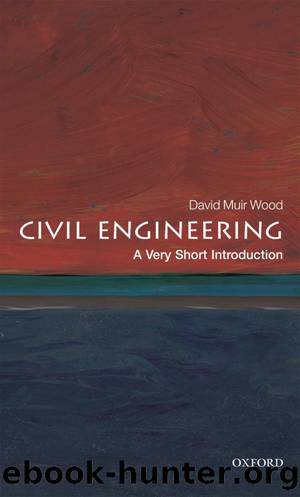Civil Engineering: A Very Short Introduction by David Muir Wood

Author:David Muir Wood [Wood, David Muir]
Language: eng
Format: epub
ISBN: 9780199578634
Publisher: Oxford University Press
Published: 2012-01-15T07:00:00+00:00
Earthquake
Major earthquakes occur every year in different parts of the world. The various continents that make up the surface of the Earth are moving slowly relative to each other. The rough boundaries between the tectonic plates try to resist this relative motion but eventually the energy stored in the interface (or geological fault) becomes too big to resist and slip occurs, releasing the energy. The energy travels as a wave through the crust of the Earth, shaking the ground as it passes. The speed at which the wave travels depends on the stiffness and density of the material through which it is passing. Topographic effects may concentrate the energy of the shaking. Mexico City sits on the bed of a former lake, surrounded by hills. Once the energy reaches this bowl-like location it becomes trapped and causes much more damage than would be experienced if the city were sitting on a flat plain without the surrounding mountains.
Designing a building to withstand earthquake shaking is possible, provided we have some idea about the nature and magnitude and geological origin of the loadings. Taiwan is a seismically active country â the magnitude 7.6 Chi-Chi earthquake of 21 September 1999 killed 200 people. The Taipei 101 building (Figure 20) in Taiwan was, for six years from 2004, the tallest building in the world. One way to counter the oscillation of a somewhat flexible building induced by ground movement in an earthquake is to include a tuned mass damper as a passive means of extracting energy from the movement of the building. The tuned mass damper is a heavy pendulum at the top of the building which is tuned to a frequency close to that of the building and is connected through dampers (shock absorbers). The Taipei 101 damper takes the form of a golden sphere of mass 730 tonnes, built up from steel plates, suspended from eight steel cables, and connected through eight dampers. It is very much on display to visitors who come to the viewing galleries around the 90th storey and who are encouraged to look inwards as well as outwards. It provides an opportunistic but low key example of the importance (and beauty) of civil engineering and the contribution that it makes to the safety of the built infrastructure.
Download
This site does not store any files on its server. We only index and link to content provided by other sites. Please contact the content providers to delete copyright contents if any and email us, we'll remove relevant links or contents immediately.
| Automotive | Engineering |
| Transportation |
Machine Learning at Scale with H2O by Gregory Keys | David Whiting(4183)
Never by Ken Follett(3791)
Urban Outlaw by Magnus Walker(3342)
OPNsense Beginner to Professional by Julio Cesar Bueno de Camargo(3251)
Sapiens and Homo Deus by Yuval Noah Harari(2987)
Will by Will Smith(2793)
A Short History of Nearly Everything by Bryson Bill(2629)
Hooked: A Dark, Contemporary Romance (Never After Series) by Emily McIntire(2502)
Rationality by Steven Pinker(2291)
Borders by unknow(2229)
The Becoming by Nora Roberts(2088)
Holy Bible (NIV) by Zondervan(2087)
The One Percenter Encyclopedia by Bill Hayes(1787)
HBR's 10 Must Reads 2022 by Harvard Business Review(1777)
Freedom by Sonny Barger(1771)
A Short History of War by Jeremy Black(1762)
Five Ways to Fall by K.A. Tucker(1700)
Go Tell the Bees That I Am Gone by Diana Gabaldon(1687)
Girls Auto Clinic Glove Box Guide by Patrice Banks(1685)
